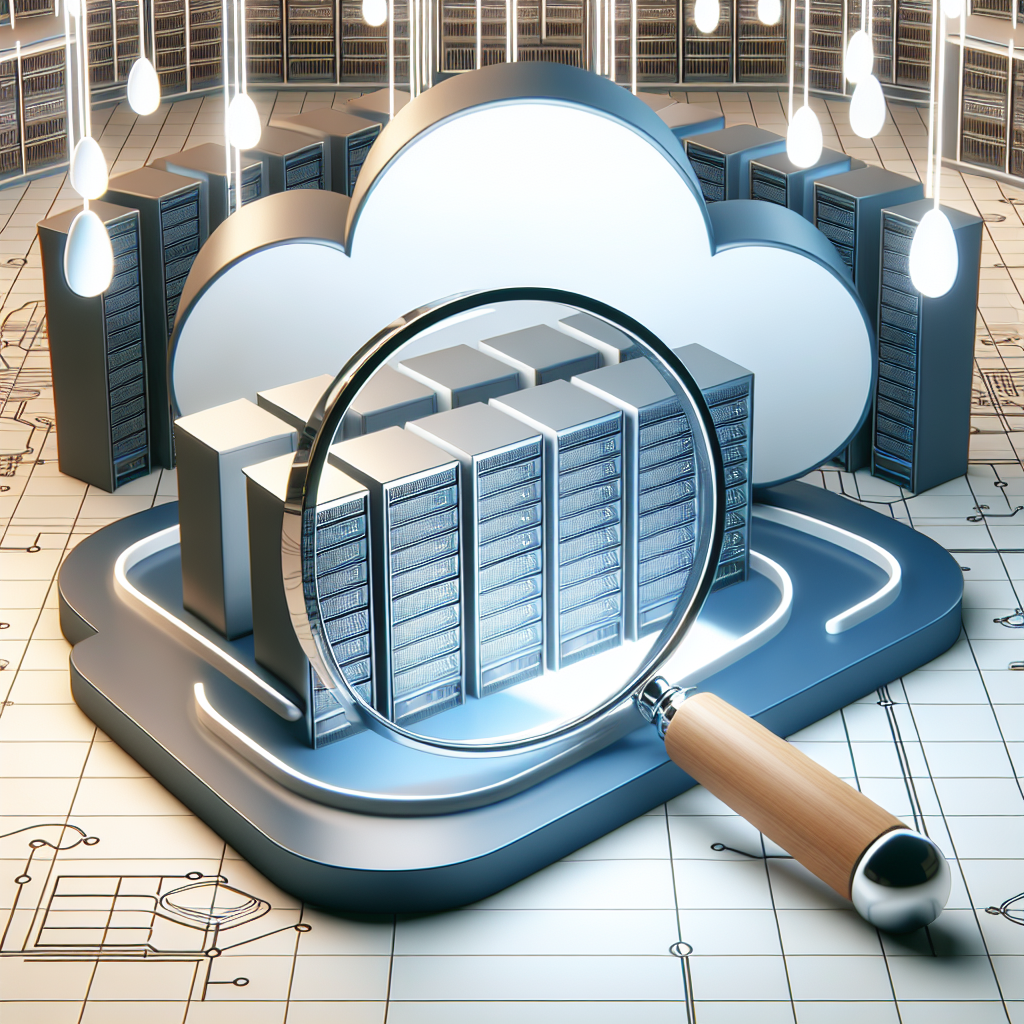Your cart is currently empty!
Tag: Big

Optimizing Data Center Databases for Big Data and Analytics
Data centers play a crucial role in the digital age, serving as the backbone for storing and processing vast amounts of data. With the rise of big data and analytics, it has become more important than ever for organizations to optimize their data center databases to efficiently handle the massive amounts of information generated on a daily basis.Optimizing data center databases for big data and analytics involves several key strategies and best practices to ensure data is stored, processed, and accessed in a way that maximizes performance and efficiency. These strategies include:
1. Choosing the right database technology: There are various database technologies available, each with its own strengths and weaknesses. Organizations should carefully evaluate their needs and choose a database technology that is well-suited for handling big data and analytics workloads. Some popular options include relational databases, NoSQL databases, and in-memory databases.
2. Scaling for performance: As data volumes continue to grow, it is essential to scale databases to accommodate the increasing workload. This can involve adding additional servers, optimizing database configurations, or implementing sharding techniques to distribute data across multiple servers for improved performance.
3. Implementing data compression and indexing: Data compression and indexing can help reduce storage requirements and improve query performance. By compressing data and creating indexes on frequently queried columns, organizations can speed up data retrieval and analysis processes.
4. Utilizing parallel processing: To handle large volumes of data efficiently, organizations should leverage parallel processing techniques to distribute workloads across multiple CPU cores or servers. This can significantly improve query performance and reduce processing times for complex analytics tasks.
5. Implementing data partitioning: Data partitioning involves dividing large datasets into smaller, more manageable chunks that can be processed independently. By partitioning data based on specific criteria, organizations can improve query performance and optimize data retrieval for analytics purposes.
6. Monitoring and optimizing database performance: Regular monitoring of database performance is essential to identify bottlenecks, optimize query execution plans, and fine-tune database configurations for optimal performance. By analyzing performance metrics and making necessary adjustments, organizations can ensure their databases are running efficiently and effectively.
In conclusion, optimizing data center databases for big data and analytics is crucial for organizations looking to harness the power of data for informed decision-making and competitive advantage. By implementing the strategies and best practices outlined above, organizations can ensure their data center databases are equipped to handle the challenges of big data and analytics workloads efficiently and effectively.

Big Data for Urban Sustainability: A Human-Centered Perspective

Big Data for Urban Sustainability: A Human-Centered Perspective
Price : 22.76
Ends on : N/A
View on eBay
In recent years, the concept of big data has become increasingly important in the realm of urban sustainability. As cities around the world grapple with issues such as climate change, resource scarcity, and population growth, the ability to collect and analyze large amounts of data has become crucial for making informed decisions and driving positive change.However, while big data has the potential to revolutionize urban sustainability efforts, it is important to take a human-centered perspective when implementing these technologies. It is not enough to simply collect data for the sake of it – we must also consider how this data can be used to improve the lives of city residents and create more sustainable, equitable, and resilient communities.
One key aspect of a human-centered approach to big data for urban sustainability is ensuring that data collection and analysis processes are transparent and inclusive. Citizens should have a say in how their data is collected and used, and efforts should be made to address concerns around privacy and data security.
Additionally, it is important to consider the social and cultural context of data collection and analysis. Different communities may have different needs, priorities, and values, and it is important to take these factors into account when designing and implementing big data projects.
Ultimately, by taking a human-centered perspective on big data for urban sustainability, we can ensure that these technologies are used in ways that benefit all members of society and help to create more livable, sustainable cities for future generations.
#Big #Data #Urban #Sustainability #HumanCentered #Perspective
The Role of Data Center Servers in Big Data Analytics and Machine Learning
Data centers play a crucial role in the world of big data analytics and machine learning. These massive facilities house a large number of servers that store, manage, and process the immense amount of data generated by organizations every day. In this article, we will explore the role of data center servers in enabling big data analytics and machine learning.Data center servers are the backbone of big data analytics and machine learning. These servers are responsible for storing and processing vast amounts of data collected from various sources such as sensors, social media, and customer interactions. The servers are equipped with powerful processors, memory, and storage capabilities to handle the complex algorithms and computations required for analyzing and deriving insights from large datasets.
One of the key roles of data center servers in big data analytics is to provide the necessary computing power for processing and analyzing large datasets. With the increase in data volume, velocity, and variety, traditional computing systems are unable to cope with the demands of big data analytics. Data center servers are designed to handle the massive scale of data and perform complex calculations in real-time, enabling organizations to derive valuable insights and make informed decisions.
Machine learning, a subset of artificial intelligence, relies heavily on data center servers for training and deploying models. Machine learning algorithms require large amounts of data to learn patterns and make predictions. Data center servers provide the computational resources needed to train machine learning models on massive datasets, enabling organizations to build accurate predictive models for various applications such as fraud detection, recommendation systems, and image recognition.
In addition to processing and analyzing data, data center servers also play a crucial role in ensuring the security and reliability of data. Data centers are equipped with advanced security measures such as firewalls, encryption, and access controls to protect sensitive data from unauthorized access and cyber threats. Redundant power supplies, cooling systems, and backup generators ensure the continuous operation of servers, minimizing the risk of data loss or downtime.
As organizations continue to generate and collect vast amounts of data, the demand for data center servers will only increase. Data center providers are constantly investing in new technologies such as cloud computing, virtualization, and edge computing to improve the performance and efficiency of servers for big data analytics and machine learning. By harnessing the power of data center servers, organizations can unlock the full potential of big data analytics and machine learning to drive innovation, optimize operations, and gain a competitive edge in today’s data-driven world.

The Qualcomm Equation: How a Fledgling Telecom Company Forged a New Path to Big Profits and Market Dominance
Price: $19.10
(as of Nov 19,2024 16:41:24 UTC – Details)From the brand


Scroll right for more great reads.


HarperCollins Leadership publishes content from leaders who redefine or expand what a reader previously thought possible.
Our authors provide unique inspiration and experiences to those who seek to learn, make a difference, and find their own version of success.
Our Best-Sellers
People Management
Leadership Training
Personal Development
Marketing & Selling
Personal Finance
Publisher : Amacom; First Edition (March 4, 2005)
Language : English
Paperback : 288 pages
ISBN-10 : 0814409970
ISBN-13 : 978-0814409978
Item Weight : 14.4 ounces
Dimensions : 5.8 x 0.65 x 8.9 inches
In the competitive world of telecommunications, one company has managed to rise above the rest and establish itself as a dominant force in the industry. That company is Qualcomm, a once-fledgling startup that has now become a powerhouse in the world of mobile technology.The Qualcomm Equation is a fascinating look at how this company managed to not only survive but thrive in an industry dominated by giants. From its humble beginnings in 1985 as a small startup in San Diego, Qualcomm has grown to become a global leader in wireless technology, with a market cap of over $100 billion.
So, how did Qualcomm manage to achieve such success? The answer lies in its innovative approach to technology and business strategy. Qualcomm was one of the first companies to recognize the potential of digital communication and invest heavily in developing cutting-edge technologies that would revolutionize the way we communicate.
One of Qualcomm’s key innovations was the development of CDMA technology, which allowed for more efficient use of the available spectrum and paved the way for the development of 3G and 4G networks. This technology gave Qualcomm a significant competitive advantage over other companies in the industry and helped propel it to the top of the market.
But Qualcomm’s success was not just due to its technological innovations. The company also had a strong focus on building strong relationships with its customers and partners, which helped it to establish a strong presence in key markets around the world.
Today, Qualcomm is a dominant force in the telecommunications industry, with a strong presence in everything from smartphones to automotive technology. The Qualcomm Equation is a testament to the power of innovation, determination, and strategic vision in building a successful company in a competitive industry.
#Qualcomm #Equation #Fledgling #Telecom #Company #Forged #Path #Big #Profits #Market #Dominance
The Role of Data Center Databases in Big Data Analytics
Data centers play a crucial role in the world of big data analytics, serving as the central hub for storing and processing vast amounts of information. At the core of these data centers are databases, which are essential for managing and organizing data in a way that is accessible and usable for analytics purposes.Data center databases serve as the foundation for big data analytics, providing a structured framework for storing and retrieving information. These databases come in various forms, such as relational databases, NoSQL databases, and in-memory databases, each offering unique features and capabilities to support the diverse needs of data analytics.
Relational databases are the traditional choice for storing structured data in a tabular format, making them ideal for applications that require complex queries and transactions. NoSQL databases, on the other hand, are designed to handle unstructured and semi-structured data, providing flexibility and scalability for big data analytics. In-memory databases offer high-speed data processing by storing data in memory, rather than on disk, enabling real-time analytics and faster query performance.
The role of data center databases in big data analytics extends beyond just storage and retrieval. These databases also play a crucial role in data processing, transformation, and analysis. By leveraging advanced query languages, indexing techniques, and optimization algorithms, databases enable data analysts to extract valuable insights from large datasets efficiently.
Furthermore, data center databases provide security and governance features to ensure the confidentiality, integrity, and availability of data. With robust access controls, encryption mechanisms, and audit trails, databases help organizations comply with regulatory requirements and protect sensitive information from unauthorized access.
In conclusion, data center databases are the backbone of big data analytics, enabling organizations to harness the power of data for informed decision-making and strategic planning. By leveraging the capabilities of relational, NoSQL, and in-memory databases, businesses can unlock the full potential of their data and gain a competitive edge in the digital age. As the volume and complexity of data continue to grow, the role of data center databases in big data analytics will only become more critical in driving innovation and driving business success.

Understanding the Role of Data Center Servers in Big Data Analytics
In today’s digital age, the amount of data generated by businesses and individuals is growing at an exponential rate. This data, commonly referred to as big data, holds valuable insights that can help organizations make informed decisions and drive business growth. However, the sheer volume and complexity of big data present a challenge for traditional data processing systems. This is where data center servers play a crucial role in enabling big data analytics.Data center servers are the backbone of any organization’s IT infrastructure, providing the computing power and storage capacity needed to process and analyze large amounts of data. In the context of big data analytics, servers are responsible for collecting, storing, and processing data from various sources in real-time. They play a key role in running complex algorithms and data processing tasks to extract meaningful insights from the data.
One of the key advantages of using data center servers for big data analytics is their scalability. As the volume of data continues to grow, organizations can easily scale up their server infrastructure to meet the increasing demand for computing power and storage capacity. This scalability allows businesses to handle large amounts of data efficiently and effectively, without compromising on performance.
Another important aspect of data center servers in big data analytics is their ability to handle different types of data. Big data often comes in various forms, including structured data (such as databases), unstructured data (such as text and images), and semi-structured data (such as XML files). Data center servers are equipped with specialized software and hardware that can process and analyze all types of data, providing organizations with a holistic view of their data assets.
In addition, data center servers play a crucial role in ensuring data security and compliance. With the increasing focus on data privacy and regulatory compliance, organizations need to ensure that their data is stored and processed securely. Data center servers are equipped with robust security features, such as encryption and access controls, to protect sensitive data from unauthorized access and breaches.
Overall, data center servers are essential components of a successful big data analytics strategy. They provide organizations with the computing power, storage capacity, and scalability needed to process and analyze large amounts of data efficiently. By leveraging the capabilities of data center servers, businesses can unlock the full potential of their data assets and gain valuable insights that can drive business growth and innovation.

